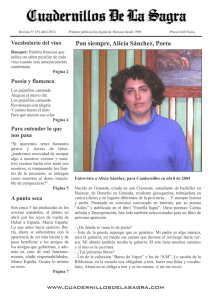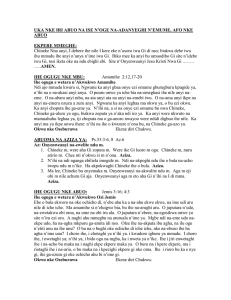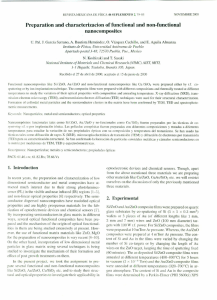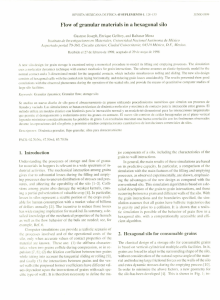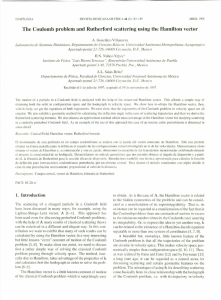Longitudinal Study of the Stability of Expressed Emotion in Families
Anuncio
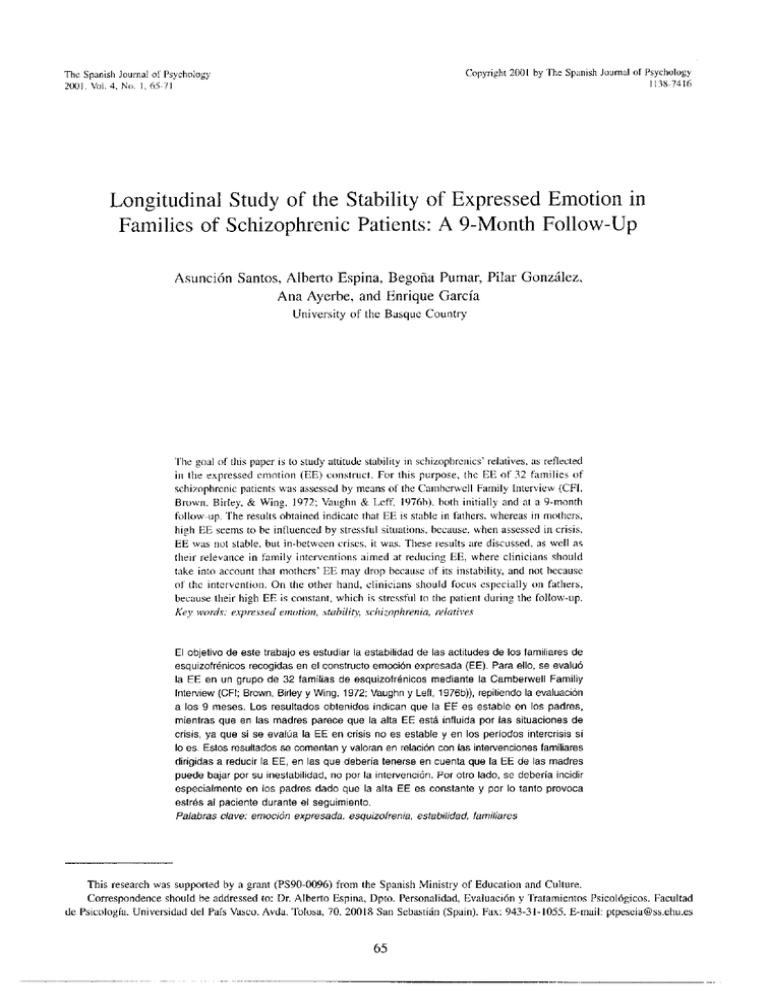
Copynght 2001 ½ The Spanish Jotírnal of Psychology Thc Spanísh Joutnal of Psycholog~ 2001 VoL 4 No 1,6571 1138-7416 Longitudinal Study of the Stability of Expressed Emotion in Families of Sehizoplirenie Patients: A 9-Month Follow-Up Asunción Santos, Alberto Espina, Begoña Pumar, Pilar González, Ana Ayerbe, and Enrique García University of the Basquc Country Ihe goal of ihis paper is to study attitude .stabiliry o schizophrcnics’ relatives, as refleoled o Ihe expressed ornotion (FE) construct. For this purpose, tk FE of 32 farnilies of schizophrenic parienís was assessed by means of 11w Camhcrwcll Farnily lnterview (CFI. Brown. Birley, & Wing. 1972; Vaughn & Lctt 1976b). both initially and al a 9-month follow-up. The resulis oblained indicate thaI FE is síable ji, fathers. whereas jo rnothers, high EF seems Lo be influenced by stressft¡l situarinos, because. when assessed jo crisis. EE was nol stable. boL in-betweeo crísc~., it was. These resulis are discossed, as well as iheir relevance in faínily intcrvcntions ajmed aL reducing FE. where clinicians shoold Lake into accoont thai mothers’ FE may drop because of ti instabiLity, and nol hecause of Ihe intervention. On Lhe olher hand, clinjejaní shoold fociís cspccially on fathers, because iheir high EF is constaní, which is stressfiíl tu (he patiení during the follow-op. Key u’ords: expressed e,nc,tion ,s tobillo; schizophrúnia, rúlotives El objetivo de este trabajo es estudiar la estabilidad de las actitudes de los familiares de esquizofrénicos recogidas en el constructo emoción expresada (EF). Para ello, se evaluó la EF en un grupo de 32 familias de esquizofrénicos mediante la Camberwell Familiy nte,view (CFI; Brown, Birley y Wing, 1972; Vaughn y Leff, 1976b)), repitiendo la evaluación a los 9 meses. Los resultados obtenidos indican que la EF es estable en los padres, mientras que en las madres parece que la alta FE está influida por las situaciones de crisis, ya que si se evalúa la EF en crisis no es estable y en los periodos intercrisis si lo es. Estos resollados se comentan y valoran en relación con las intervenciones familiares dirigidas a reducir la FE, en las que debería tenerse en cuenta que la FE de las madres puede bajar por so inestabilidad, no por la intervención. Por otro lado, se deberia incidir especialmente en los padres dado que la alta EF es constante y por lo tanto provoca estrós al paciente durante el seguimiento. Fa/abras clave: emoción expresada, esquizofrenia, estabilidad, familiares This research was supported by a grant (PS9O-0096) from 11w Spanish Ministry of Education and Culture. Correspondence shoold be addressed lo: Dr. Alberto Espina, DpLo. Personalidad, Evaluación y Tratamientos Psicológicos. Facultad de Psicolo4a. Universidad del País Vasco. Avda. Tolosa, 70. 20018 San Sebastián (Spain). Fax: 943-31-1055. E-mail: ptpescia@ss.ehu.es 65 66 SANTOS. ESPINA. PIJMAR. GONZÁLEZ. AYFRBE. AND GARCíA The atíiíudes of the relatives toward paiients, included in ihe consrruot expressed enwlwn (EF). aro an i uportaní predictor of relapso iii schizophrenic patients (Brown, iíirley, & Wing, 1972; Brown. Monck, Carstairs, & Wing. 1962; Brown & Ruitor, 1966; Rutter & Brown, [966; Vaughn & Loff, 1 976b). Cross-cnltural sitidies have confi rniod ihe assoeiation of high EF and relapso in schizophrenie patienis (Arévalo & Vizoarro. ¡989: Cazzullo, Bressi, Berirando, Clariel, & Maffei. [989; Gutiérrez ot al.. 1988; Hashorni & Coclirane, 1999; Karno et al.. 1987: Loff el al., 1987; Molino. Singh, Morris, & Moltzer, 1985; Pellizzer, Banelet, & Ammann, 1987; Santos, 1995; Vauglin, Snyder, iones, Freernan, & Falluon, 1984). Bobbington aud Kuipors (1994) rovised 25 strdios of FE as a prodicior of relapso in schizophrenics and found íhat 50% of patients in high FE onvironmonts rolapsed, comparod tu 21% in low FE environmonís. The temporal stahility of EF and the altitudes that conform this construol aro ono of the problems thai. although taken mio account in sorne of the FE projecís (Brown et al.. 1972; DuIz & Hand, ¡986: Hogariy el al., 1986; Leff, Wig, Bedi, & Manon, 1990; McCroadie, Roboríson. Hall, & Bcrry, 1993; Tarrier, Barrowclough, Porcoddu, & Watls, 1988), has noÉ beon siudied lo deptk There is a recurring but unsolved issue: Does EF rellect a síable and fixed paiiem of relativos’ attitudes, or is it a temporary state that appears in assucation with iho pationts mental state? Brown et al. (1972), in a sttidy of FE at disehargo and at the %month follow-up, found thaI Citicism was unstable, whoroas Emotional Overinvulvernont remained stable. Fhis observation highlights the difficulty of studying iho FE síability index, bébátáéth& áttitiide<ófíhéstkbáiiés (Criticism, Fmuiiunal Overinvolvement, and Hostility) are likely to chango at differont times. Qn the olher hand, it seems that the issue of FE stability is more ovidení when EF is assessed in momenís of crisis Ihan when the patient is syrnptoniatically stable (DuIz & Hand, 1986; Leff el al., 1990; Tarrier, Barrlowclough, Vaughn, et al., 1988). Leff, Kuipers, Berkowiiz, EberloinVries, and Sturgeon (1982) ubsorvod thai 2 uut of every 8 relativos changod spuntaneously frum high tu low FE in a 9-month periud. The observed chango was in Criticism, similarly [o (he study by Brown et al. (1972). DuIz and Hand (¡986) observed thai EF shifted from high lo low in 50% of the relativos. Theso authors roported thai [he varialiun coníd be duc lo a rogression effect; huwever, thoy shuwod that only 1 out of 6 people whu were al first low iii EF, shifted tu high 12 months laten 1-lugarty el al. (1986) fot’nd that II out of 44 high-EF families bocamo low in a 12month periud. Tarrier, Barrluwcluugh, Porceddu, el al., (1988) obsorved thai? out of 16 familios changod frorn high [o low EF lo 9 months. Fovrc, González. and Lendais (1989) found roasonable evidence of slability in FE, because most of [he 35 relativos of [he 22 schizophrenic patienís studied remained síablo. These authons repurted thai vory few of ño ubserved changos were due to the patienis symptomaiology. Loff el al. (1990) fuund ihat 79% of [he relativos changed frurn high tu low FE in a 1-yoar period. Thoso resulís end weighí tu Kuipors and [lebbington’s 1988) idea thai siales thai relativos coild be elassifiod mio íhree gruups: Thuse whu are 0w in [YEand whu cupe adoquaiely with disease; thuse low in EF and whu itiro high al tinos of crisis: Ihuse who are high in FE in a stable way. FE stabiliíy should also be assosso(l íaking mio accoení (he chango in relativos’ coping siralegies, ;¡s wel ¡ as pationí ‘s symplornatology and behavior. MeCreadie ci al. (1993), in their slt’dy of FIS stability. uutlinod threo calegories: High EF. Low FE, and Fluciuadng FE. In a 5-year fullow-up, those atithurs concluded that 63% of Iho siudied relativos xvere stahlo in FE. Scazufca ané Kuipors (1998) found 63.9% stabilitv at 9 munths. The purpuse of this paper is tu study EF stability ata 9monih folluw-up in a group of familios wil.h a schizophronic SOl] or daughter. Wc wished tu tesi ihe following hypoihesos: (a) i n mosí cases, EF xvi II romain stablo al ño 9-month follow-up; aud (b) ILE wi II be mole síable it iho patiení 5 assessed when noÉ in crisis [han whe¡í in crisis. Meihud Participants Participants were 32 schizophrenic patienis and ihoir relativos. Twenty-eighl paiients lived with buth parenís, 3 wilh only their mothers, aid 1 with his father. Ono uf the tattíers cutid not be assessod at the 9-rnonth foiiuw-up. lo this sludy, “family’ is dolinod as ihe father, Ihe moiher, and [he schiz.ophronic son or daughten Selection entena were: (a) individuals wilh a diagnosis of schizuphronia basod un Ihe entena established by tho I)iagno.stie and Staustwaí Manual of Mental Di.sorders 3rd edition, revisod (American Psychialric Associatiun, 1987); (b) age between 15 and 35 years; (o) singlo porsuos living with their parents: and (d) not having previously roceived any family iolerventions. The pationts woro rocruitod from Iwo hospitals and (wo Mental Health Conters of tho Basquo Health Servico (Osakidotza) during [997 and 1998. Ihe familios xvere informed thaI Iho study was suppurted by ño Mioistry of Education and Culturo. The schizophrenic patienís studiod, 24 men and 8 womon, with a mean ago of 25 years (tange 17-34), usually unly pussessed a primary oducational level or incompleto tochoical siudies, and xvoro mustly unempluyed. Tho clinical characteristios of the palienis wore: mean ace al onsei, 18.9 years (SD = 3.1); mean illness duration, 75.2 rnoníhs (813 = 45.7); mean number of hospital admissions, 2.4 (SD = 3.2); mean stay in hospital, 3.0 munths (SD = 4.9). With regard tu Iho charactenistics uf the schizuphronia, and based un the DSM-IJI-R ([987), 25% STABILITY OF EXPRFSSED EMOTION (EF) were disorganized. 46.8% paranoid, 15.6% undifferentiated, and 12.5% residtíal. As for Ihe course of schizophrenia, 87.50/o were chronic and 12.5% subchronic. ‘[‘he onset was insidious in 65.6% of Ihe schizophrenics and sudden in 34.3%. Of theso patients, 46.8% wcre not jo crisis and 53.2% were in crisis. Typically. [he faíhers. whuse mean age was 58 years (range 48-84), had unly a primary educational level and wore blue-cullar workers. The mothers, whose mean age was 55 (rango 47-64), also had a primary oducational level and musí uf Ihon] were hutísewivos. Noarly alí of the families (96.9%, u = 31) livod in urban aroas and 68.8% (e = 22) were uf averago sucio-economio lovel. The mean number uf family mernbers was 5.2. aud of members whu lived at humo, 4.3. Instrurnenis and Procediste Patienis’ Clin¡cal State DSM-III-R (1987). Tho DMS-III-R entena wore assessed by means of an audioíapod interview. Theso cniteria had also boen assessed proviously by [he psychiatrist who referred the patient tu us. Brief Psychiatric Rating Seale-Expanded (BPRS-E; Lukoff, Liberman, & Nuech[erlein, 1986). AII patients were rated with this seale upun diseharge from the hospital. The BPRS-E consists uf 24 [oms. The manual (Lukuff, Nuechteriein, & Ventura, ¡986) presents a somisaucturod interview tu gather information un Ihe 24 item~., the uporalionalized dofinitions of tho cuntení of each item, and its scure un a 7-poiní Likert-type soale. A seore uf 1 indicares that the symptom is out present; 2-3 indica[es lhat Ihe intensity of Ihe symprum is nol patholuoic (svnhpton¡ presetil to a slight or ver-y sUglír degree); and a seure of 4-7 reflects paíholugical inlensity uf Ihe symptom at fuur levels (moderare, rnoderarelv severe, sevete, and e.r.trenely severe). Ratings wero compiled un the basis uf brief individual interviews conductod by mernbors of tho research group. Tho raters had boen Iurmally trained in tho use of the BPRS prior tu Iho study, and inter-rater reliabili[y for I3PRS total seures was ~ = .88. Fanzilies Expressed Emotion Canzberrvell Eandly Interview (CFI; Brown el al., 1972; Vaughn & Leff, 1 976b). Once Iho pationts had satisfod the DSM-III-R entena fur schizuphrenia, [hoir parents wero cuntacted and asked tu participate in [he study. U they agreod. Ihe Camborwell Family lntorviow was individually administorod tu them. By moans of tho CFI, family FE, fathers’ FE, and muthors’ FE were studied. The CFI isa 1hour, semistructured, audiotapod interview (br use with Ihe patient’s key relativos. The eonlent of the interview lucuses un thc onsol aod dovolupment uf thc patient’s must recent schizophrenic episode aoci Iho impact of this episude un he 67 family envirunmení during thc 3 mun[hs prior lo Iho patient’s hospital admissiun. The number uf critical eomments made hy the relativo, ur statements uf dislike or reseotmonl of Ihe patient aro counled by a trained judge following the interview. lo additiun. ratings are made un the degree tu which the re!a[ive oxpresses omotionally uverinvolved or markodly protective and overcuncorned attitudes tuward the patient, both as they are manifosted duning Ihe intorview and thruugh repurís provided by the rolative of incidenís uccui~ing outsiríe tho intorview. These ratiogs aro based un a 0 (absení) tu 5 (extren¡elx’ lzigh) soale. EF is a construct whuse measurement depends nut just un contení, but un tho assessment of vocal attribuíes: spood, pitch, aod emphasis of voice. A variety of ratings can be mado, but Ihuse fuund tu be predictivo of schizophrenia encompass twu distinct features of relativos, thaI of criticism and hostility, and that uf emutiunal overinvulvemeor. Criticism (CC) is defined as the disliko or disapproval of a persun’s behavior un charactoristios: “He never stuppod smoking and smoking and smoking.” Hostility (H) is a more frank expnossion of theso feelings: “1 wish he was doad.” As hustility is rarely present withuul criticism, it has relativoly little valtre as an indepondení predictor. Both these ralings can be ubserved acruss Ihe whulo rango of relativos, and reflecí a diffictilty jo tuleratiog, aid sometimos o understanding, Iho situation. Emotional oveninvolvement (EOI) cumprises aspects uf ovenprutectiun, solf-sacrifiee, aud emutiunal upset. It can be cumpanod tu troating [he patient rather Iiko a child, with consequoní inapprupniate levels of concern displayod by the relativo: “They thuught 1 was [he patient.” “I’d lust so much weighl, 1 cuuldn’t sloop fon wurry.” The patient is thon perceived as less competenr and muro vulnerable, nesulting in a reversal uf the prucess of adult individuation and sepanalion. Positivo Remarks is a quantitativo seale tu recurd oxpressions uf valuo or approciatiuo: “He is a good boy.” Warmíh is a global seale tha[ rangos fnum O tu 5 aod ¡ates displays of affoclion and interesí. Foíluwing administra[ion of Ihe CFI, [he panents’ taped interviews were natod by fuur judgos whu had pneviuusly comple[ed a 2-week EF-eoding workshup conduc[ed by Chnistino Vaughn. By the end of [he prugram. the naters had tu achievo rninimum noliability cuoffioionts of y = .80 for ratings of numbor of critical comments aod positivo remarks and for judgements uf high- vorsus luw-FE s[alus and highvorsus luw-EOI status, FOl and H (t = .80) aod warm[h (r 5 = .80) compared with sample-tape entonen ratings, oslablished prior tu [he training prognam. Thus, alí of Ihe tapes in tho prosont study wore cuded by judges who had altained rhis level of reliability by tho cod of tho training period. Altlíough ah toam members achievod the rehiability required by Vaughn, Ihere wono sume diffieullies roferriog tu specific aspecís of [he Spanish culture. especiaíly when assessing FOl. Becauso uf this, wo porformed an ioterjudge 68 SANTOS, ESPINA, PUMAR, GONZALEZ, AYFRBE, AND GARCÍA neliability test un the raters. This aoalysis was porfornied un 20 intonviews with sehizopronies’ relativos, adaptiog the exprossioos and theír assossmeot tu our culture, especiaiiy as negards FOl. The iotenjudge neliability ubtaioed rangod betweeo .80 and .85 for eaoh subseale. Specific dotibís wore consulíed porsunally with Vaughn. CFI seoros uf 6 or nove crilicisms and/ur ratiogs of 3 (moderatelv higlí) or highor 00 FOl and/ur preseoce of 11 classified a parent as high EF. Parents who did out satisfy thcse entena wene designated low FE (Vaughn & [oíl, 1976a). A family was cunsiderod high FE whon, jo thc case uf two-paron[ families, either uno ur buth parents satisfied nho entena fur iodividua[ high-EE status, lo Ihe caso of siogle-panent familios, [he EE status of tho farnily was that of Iho individual panent. lo urder tu study EF slability uver timo, Iho EF mdcx was assosscd twico (initial assessrneni aocI 9- n]ooth téiIowup) in tho 32 families. Fur this purpose, wo usod hoth tho to[al group (N = 32) and two soparate groups: patients in crisis (u = 17) aod nut in crisis (u = 5) aÉ Iho initial assessmcnt. Wo considered as boiog in crisis those patienís who, at Ihe initial assessmeot, seorod 6 (severo) or 7 (eAtremelv severe) o any of the fulluwing jtoms uf [he BPRS: contení uf abourmal thinking, hallucinaiions. or conceptual disorganizatiun. Nono uf Ihe palionts was o crisis an Iho 9-month fulluw-up, exeept fur une whose rnothor (a wjdower) was luw FE al buth assessmcnts. Statist¡cal analyses Tho analyses used woro Wileoxuo nun-paramotrical test fon Ihe quantitativo variables aoci MeNomar ouo-paname[rical test for paired clata. The statisíical aoalysos were carried uní by moans uf Ihe Síatistical Packago fon Social Seiencos (Nurusis, 1997), Spaoish version 7.5 fon Windows. Results Stabilitv of tite Expressed Enroñan Status As seco in labIo 1. o iho total groop, otil of tho 15 highEF fathers (60%), 9 rooai oed high io EF a Ihe 9—monlh fulluw-up, xvheroas 6 (40’)o) shiftod Lo low FE. Out uf Ihe 13 luw-EE fathers (76.9%). 10 remained luw al ño follow— up, and 3 (23.1%) changod tu high FE. ‘¡‘he slahility porceotago. 67.9% in general, xvas grealer amoog íhe luwEF fathers (76.9%) than aniung the high-EE fathors (60%). The chango in Ihe fathers’ FE mdcx (u = 28) al tho initial assessnionl and at the 9-rouoth fullow—up was stalistcally nuosigoificaní. ThaI is, FE romainod síablo io alí tho househulds. Takioo mío accuonn Iho EF índex uf Ihe 31 oiuíhers. we ubserved íhat 13 uut uf 24 who were initially high in EF (77.4%) maintainod this status (54.2%). whereas II shifted tu a low-EF iodex (45.8%). Four out of 7 muthers who showed an initial low-EE iodex maintained their status (57.1 %), and 3 shiflod tu high EF (42.9%). Ihe chango o ihe rnolhers EF índex (u = 31) at Ihe initial assessmeol. and at tho 9-month fulluw-up was staíisnieally nuosigoificaní. iodieating thaI FE nomainod síable in alí househulds. In ihe total group (u = 32), families’ EF (i.e., mothers’ aod fathors’ FE), along with Iheir subseales. nemainod mure síablo. statistically speaki ng, thruughout the 9 monlhs. mostly doc no Ého stability uf low ElY jo the fathers. The mean stabi lity in fathens was 74%, whercas jo niothers, it was 54%. rovealiog molhers tu be moro unstable, espocially thoso high in EF and in any uf its subseales. With rogard tu ¡he subseale seores, ¡o fathers. high FOl was ihe must tostable anid luw FOl Ihe most stable (althuugh statistically oonsgoifieaot). Ihe most unstable subseale seore in mothers \vas EO[, (p = .t)I). Tablo ¡ Stability pitE in tic Thtal (iroup Family FE Fathors’ EF Fathons’ CC Fathors’ FOl Fathers’ U Molhers’ EF Mulhens’ CC Mothers’ EQI Mulhers’ H STAI3ILITY INSTABILElY ‘4%) STABILITY u(%) INSTABILITY n(%) 11101-1 FE H[Gtl-*LOW LOXV FE LOW—’lIlGlvl 5 (71.4%) 10 (76.9%) 2 (28.6%) 3 (23.1%) 5 (41.7%) ¡4(87.5%) 4(66.7%) 7 (58.3%) 11(45.8%) 8(61.5%) 14 (63.6%) 9 (90%) 21 (95.5%) 15 (93.8%) 4 (57.1%) 12 (66.7%) 6(66.7%) 18(85.7%) ¡8 (72%) 9 (60%) 7 (58.3v/o) 2(33.3%) 5 (41.7%) 13 (54.2%) 5 (38.5%) 8(36.4%) 1(10%) Nore. FE = Exprossod emotion: CC 7 (28%) 6 (40%) Cniticism; EQI S STABILITY u p 71.9 67.9 32 28 2 (12.5%) 75 28 os. os. os. 1 (4.5%) 1(6.2%) 3 (42.9%) 6(33.3%) 3 (33.3%) 3 (14.3%) 82 71.4 54.8 54.8 45.2 61.3 28 28 31 31 31 31 Emotional oveninvolvomeol; H = Ilostilily. os. os. os. os. .1)1 os. 69 STAIIILITY OF EXPRESSED EMOTION (EF) Table 2 Stabilitv of BE ja tic Group of Patients Family FE Fathers EF Fañas’ CC Falhers’ FOl Falhcrs ¡-1 Mothors’ FE Mothers’ CC Muthors’ FOl Mothers’ H Note. FE = iii Crisis STABILITY o(%) INSTABILITY HIGI-l EF 9 (62.2%) 3 (42.9%) 2 (33.3%) 1(33.Yi.) 1(16.7%) 5 (38.5%) 1(14.3%) 4 (30.8%) 0 (0%) Expresscd omotiun; CC STABILITY n(S%) INSTABILITY n(%) HIGH ±0W LOW FE LOWdllGH 4 (30.8%) 4 (57.1%) 4(57.1%) 2 (66.7%) 5 (83.3%) 8 (61.5%) 6 (85.7%) 9 (69.2%) 6(11)004) 3 (75%) 6 (85.7%) 7 (87.5%) 11(100%) 7 (87.5%) Criticism; FOL 3 (75%) 9 (90%) 3 (75%) 11(100%) = 1 (25%) 1(14.3%) 1 (12.5%) o (0%) 1(12.5%) 1 (25%) 1 (10%) 1 (25%) 0 (0%) ‘7. p 17 14 14 14 14 17 17 17 17 os os os rs os .03 os .02 .03 STA EILITY 70.6 64.3 64.3 85.7 57.’ 47. 1 58.8 41.2 St) Emotiunal uvoniovulvomoot; II = Hustility. lo families of patients in crisis (seo Talle 2), we ubserved 70.6% stability (statistically nunsigoificaní). Among tho fathens uf Ihese patienís, the chango jo FE was noÉ staíistically significan aod nho ponconíago uf stability was 64.3%. That is fathers’ FE did not chango from Ihe inilial evaluation lo the folluw-up evaluation. Huwover, in mothons, it was unstable (FE, p = .03; FOl, p = .02; aud 1-1, p = .03). lo general. regardiog pationís assessed in crisis, tho attitudes CC, buth high ant! low, boing the most unstablo sealo. EF of fathens and muthers who wore luw in FE remained síablo (90.2% of low-EF fathers aod 85% of low-EE mothers). chango in this soalo was nut stalistieally significaní cilhen in muthers un fathens, bolh jo [he gnuup in crisis un out uf crisis, takon .separatoly. Srabiliy of posilive remarks, Wc only stalistically significant chango obsenved was nelatod tu positivo nenianks in faíhers uf patieots assossed uut of crisis, (z = -2.03, p = .04). In Ihese cases, the number of positivo remarks lo paronís uf pationt.s assessod uut uf crisis (seo Table 3), rhe porcontages uf síability were higher Ihan Ihoso obsenved jo [he lutal gnoup (80.4% in fathers ant! 55.4% in mothors). lo Ihis gnuup, dio absenco of H amung fathers was ño must síable atlitude. fulluwod by low FOl, with Table 3 Stability of LE Faniily FE Faíhers’ EF Fathers’ CC Fañas FOl Fathcrs E Mothers FE Morhors CC Muthers’ FOl Mothers E Note. FE = iii was stable both iii fathors ant! muthers. Stability of Warrnth ami Positive Rernarks Srability cf warmrh. Warmth was nocudod as high un Iow with a cut-off poiní of 3 (hi«h warmffi > 3). Warmth in the fathons uf the total gnoup was dio must síablo. The fije Group of Patients O~a of Crisis STABILITY o(%) INSTABILITY n(%) STABIUTY n(%) INSTABILITY % ‘d%) STABILITY HIGH FE HIGH-’LOW LOW FE LOW- 411GB 9 (75%) 6 (75%) 5 (83.3%) 1(3 3%) 4 (66.7%) 8 (72.7M) 4 (66.7%) 4 (44.404) 3 (25%) 2 (25%) 1(16.7%) 2 (66.7%) 2 (33.3%) 3 (27.3%) 2 (33,3%) 5 (55.6%) 2 (66.7%) 4 (66.7%) 7 (87.5%) lO (90.9%) 8 (100%) 1(33.3%) 3 (37.5%) 3 (60<4) 1 (33.3%) 2 (33.3%) [(12.5%) 1(9.1%) (1(0<4) 2 (66.7%) 5 (62,5%) 2 (40%) 73.3 71.4 85.7 78,6 85.7 64.3 50 50 15 14 14 14 14 ¡4 14 14 1(25%) 3 (75%) 7 (70%) 3 (30%) 57.1 14 Expressod eniolion: CC Cniticiso]; FO! = Ernutional overinvulven,ent; H = Hostility. jj p os os os os os os os os os 70 SANTOS. ESPINA. PUMAR, GONZÁLEZ, AYERBE. ANI) GARCíA deoneased at Ihe 9-month folluw-up (M = 2.09 ant! 0.78, rospootively, al Ihe initial ant! at tho 9-munth assessmeots). Mothors uf patioots assossod buth in crisis ant! 001 uf crisis changod their altitude tuward thoir son ur daughter. Oot uf 13 high-EE mothers, unly 5 we.re síjil high al ño 9-oionth folluw-up. This cuuid be dueto ihe fact that, jo mumonís of líigh slnoss lovels, such as Iho patient’s crisis, muíhcrs respuod by showiog high-EF altitudes as a way of cuotrulflog ihe youogster’s bohaviur, or uf roduciog teosion. Howevor. if the muthers are assessod out of crisis, Ihoir altilude íoward Iheir uffspring is mono siable: 8 out of II ñigh-FE motliers mainlained their EF status at Ihe 9-rnuoth fulluw-t¡p. porcentagos in uur group are quite high. Qur rosolIs are similar tu Ihuse ubíainod by Leff el al, (1990), in which tboy iofbrm thaI rolad vo.s changod bern higli tu luw EF ir 790/o a yoar laten ScazLfca ant! Kuipers (1998) futrod 63.9% uf síability ir FE; 25</o changed frum high tu luw aid 11% 6ooi low tu high EF. MoCroadie el al. (1993) fuond 63% uf stabilily uvor five years, buí thoy also ubsorved thaI Ihe CII may oot be sensitivo eouugh lo nícasure FE 00 of crisis, or, if FE is unly evidení al times of crisis, Ihen Ihe CH i5 001 effecíive tu ovaluate its o fluenco u llie cotoso uf llio iIlness. Anothor explanatiun is Iban dio qua 1 y <ir nho ioíeracíioos wuu íd be dífforent al limes uf crisis ant! oíl uf crisis. Tlíis is procisoly wlial we foond. Hieh-FE behaviurs aro a ehnoiiic stressur <br a vulnerable person soch as Ihe sehizuphrenic. Tho fact llíat fathers’ high Qn the uther hand, tho faíliens’ atti todo toward dio EF i s muro stablo suggesls thai fathers altitudes are a Discus si u o patien[s seems more cuostaní. Lo fact, we fount! that [LE remajnecl srab]e d oning tlie peri od belyveon llie ini tía] assossment ant! Ihe 9-month fulluw-up. Buth ir Ihe gruups asscssed o crisis ant! oit of crisis, 60% uf Ihe fathers romained high jo FE at Ihe 9-month follow-up. Those rosulís suggest tha[, in many cases, high FE in mothers is a reactiun tu the stress caused by Iho crisis. whereas in fathers, it seems tu be a trair dial roníains dic sanie throughout tino. Elio fact that Ihe fathers’ EF is muro síable Ihan the mothers’ Ieads us tu conclude [hal fathors’ high EF will aol as a stressur fon longer periods of time. The stability of EF when nícasured 001 of crisis is an jodication uf the way pareots nunmally relate tu Iheir offspring. At niumonts of crisis, althuugh EF is a prodictur uf relapso, it is not síabie enuugh tu be considored a ebrunie stressor. It may be an acule strcssur at times when uther facturs, such as taking medicaflun irregularly or síressing tifo oveots, converge. With regad [o mothens’ FOL, we found marked chances oven lime, because 55% of Ihe cases changed al Ihe fulluwop. botli from high lo luw joyel ant! vice vensa. lo oíhor studios, it was reported thaI Iho chango from high lo luw EF among moíhers was mure frcqueot (Brown el al., 1972; Hoganty e[ aL, 1986; Leff el al.. 1982; Leff ot al., 1990; Tanrier, BaTuwc]ough, Porceddu, et al., 198$). The fact thaI alt Ihe muihors who wene hostile al. the time uf crisis coased feeling huslile a[ the folluw-up supports uur idea thaI <Ns altitude is rehued tu dio stress they sufíer duriog llie crisis. Brown el al. (1912) ant! Leff el al. (1982) reponed thaI CC clianged uvor lime, whoreas FOl was síable. Qur rosolIs aro nol in accordanco wiíli Ihese because wo found that FO! changed in a vory reguiar xvay. Al the same time. wo fouod thaI, considering rnothers ant! fathers separalely, FOL dropped jo 66% ant! CC in 570/o of Iho fathers, whoreas, aoíoog oiothers, CC docreasod mono frequentiy Ihan FO! (CC druppod o 85% whereas FOl dropped ir 69%). This uccurrod rogardloss uf wheíhor we adniioisíered dio CFI during crisis o’ afror 9 rnuoths. At any ralo. the v¿ioat,&n clirorie sl.ressur Ibr the patiení. Ir musí mothors. líuwover, jI. rs :0 Mli Lucío thnt un]>’ appears al momoots of ¡upu slress, sueh as the patiool’s c~isis. For 1 his reason we cuosidor dial. o mulhers. interveotiuns aimod al reducing high FE should focos un ilio way they lace Ihe crisis aoci. iii fathors, un Iho ctaily ruutioe. Nevert.heless, iii síudies of family ioterveotions tu educo EF, reseanchers shuuld cuosider thaI [he decreaso ‘o mutliers’ h igh EF afler Ilie in terventiun oía>’ noÉ líe due tu Ihe irlerveotion ilsel 1, but tu Ihe passi ng uf lime. CI loician s shou It! al 50 lake mío aceount lhat motlíers are mure Ii kely Ihan failíers are lo altetíd suppurl gruups fon relalivos. 1luwevon, becaose high FE i o fatliers is more síable. it i .s inipurtaní tu t!esi go i o terventi un s a ¡mcd at eocuuraging fatliors tu attent! ihoso gnuups. Rete renoes A nienican l’sych1 atrie Assoc¡alioli (1 987). Lliagnosth <md .srauisxi< al ma,n,al <4 me) ial doorde jis (<d ecl., revi sed). Washington. DC A o hoí. (S par ish trans 1 atoo. Manual diag’ Jujeo y exiadístion de iras/nt,,,xs meo roles. Barcelona. M :<ssoo, 1 988). Arévalo. J.. & Vizcarro, C. (1989). NiveLes de Eniocido Expresada’ en familiares de pacicotes esquizofrénicos. Datos para una coo]paiaoion Irarseo lI<.,ral. Reejuto it’ la .Aso.iaoh$n Española de Neo ~opsir¡<i ial ría, 5, 437—451), l3obbi ngton. P.. & Ka i pons, L, (1994). The o iiical al¡ ti 1>’ uf e,’ pues sed cojo t un o Sc lii zuph reo i a. A tít ftry¿ h ¡wc/ea Seo, ,dinaí‘ie<,. 89, 46—53. Brown, (7W,. Birloy, iL/IL. & Wiog. J.K. (1972). lofluence of faoii lv tú oo 1 he cocí rse of sch zophronic cl ísordors: A op 1 ¡catio o. B,-iHsh Ion rna! <4 l’xíel ic,trv. /21, 24 1 —258. Brown. G,W.. Moock. EM., Carsca¡ns, G.M.. & W¡og, J.K. (1962). lotiuence of ami [y lije no the coorso of sclíi zophnooíc iii ness. lirilisli Jonio al 4 I’íeí o,tive mit! Social Medh loe, 1 (xS5—68. Brown. (1W., & Rotor. M. (1966>. Ihe níoasunemeou of ami y ~clivities ant! rol alíonsh¡ps: A níothodoiugical study. ¡¡¡¡man Relatioa,r, 29, 241-263. ‘71 STABILITY OF EXPRFSSFD EMOTION (EF) Cazzullo, C.L.. Bressi, (7.. Berírande, 1’.. Clorici, M.. & Maffei. (7. (1989). Sehizoplírenio el oxpression ornotionnelle familiale. Elude done population itaíionno. LEacúlíale, /5, 1-6. t)ulz. B., & llaod. 1. (1986). Short-lorrn relapso ¡o youog schizophrenics: Cao it be prodicíed and affected by famuly (CFL). patienís, aod treatroení variables? An experimental sludy. In Mi. Goleslein. 1. 1 laod. & 1<. l4ahlweg (Eds.), tr«etmenr of jobizr)ph reo<a. Berlin: 5 p~ oger—Verí ag. Fevre, 5,. González, C.~ & Leodais. G, (1989). Expressed enot¡on cf~ schuo¡~iírenwv eetaíí’es Papee preseoted al Ihe VII World Psychialy Congross. Athens. (iroece. Gutiérrez, E.. Escudero. y.. Valoro, JA.. Vázquez, MC., Castro, JA.. Alvarez, L,C., Batían. M., Blanco, .1., González, 1.. & Gómez. 1. (1988). Expnesión do eniociones y curso do La esquizofreoia: II. Expresión de emociones y corso de la esquizofrenia en pacientes en remisión. Análisis y Modificación <le Conducta. 15, 275-316. Hashenil, AH,. & Cochraoe, It (1999). Fxprossod emotion and schízophreoia: A review oF sludies acrOss cultures. 1,iterncflioncd Revií u of Psvchiatn; 11. 219.224. Hogaríy, GE,. Andorson. CM.. Reiss, Di,. Koroblilh. S.J.. Grcowald. OP.. Javna, Cl)., & Madonia. Mi. (1986). Fnviruorneoíal/persooaí i<xhcatotis ¡o Ihe cuorse of sdiizophreoia roseanch group: Famil>’ psychoedocation, social sk¡lls traloine, ant! mainlenanco chomotlionapy ir Ihe aflercaro treatmeol of schizophreoia. 1: Ono vean efíecís of a conírolled study un relapso ant! expnessed eniotion, Archives al General Psvc:hiatrx, 4.~ 633-642. Karou, M., Jookios. J.. Selva. A.. Santana. F., Telles, (7.. López, 5.. & Miníz. 1. (1987). Expressed emulion ant! schizophnenia outeome among Mexican-Amenican famulies. ¡he Jourocd <4 Nervous aoci Mental Diseasé. 175, 143—151. Koipers, L.. & llebbiogtoo. E (1988). I3xpressed eniotion resoarch ¡o .schizophreoia: Theoretical aocI clinical implications. Psvchological Medicine, 18, 893-909 Leff, IP.. Kuipers. L.. Borkuwiiz. R., Eborloin-Vries, It, & Siurgeon, 3. (1982) A controliod irial of social intervontion ir Ihe famil es of ño schizophrcnic patienís. Briuish laurnal of P’v<iiwrv, 141, 121-134. Lotf IP., Wig, N.N., Bedi, 1-?.. & Manon. O.K. <1990). Relalives’ oxpressod emotion ant! Iho courso of .sclíizoplirenia ir Chandigarh: A íwo-yoar follow-up of a finsí contad sample. Cross—cul toral psychialry. ISpecial tssue 1. British Joornal of Psvcóia’rt /56, 351-356. Lett, .7.. Wig. >4.. Ghosh. A.. Bedi, U,. Meooo. D,, Kuipers. L., Korteo. A.. Eroherg. G.. Day, R., Sartorius, N,. & Jableosky. A. (1987>. lnflueoce of relalive< expressed emotion 00 ího decirse of schizophrenia o Chandigarh. British Jaurnal of 1%vclzft<try ¡5/, 166-t 73. Lulsoff. O., Liheernan, RE, & Noechteríoin. KB. (1986). Symplum moniIon ng i o ño rehabi 1 ¡latino of sehi zophren ¡e pat enís. Sohizoplr-enia Bol/eNo. 12. 578—593. Lukoff. D,, Nuchíerlein, 1K.FI., & Ventura. 1. (1986). Appont!ix A: Manual ron Ihe Expanded I3riof Psychiatric Rating Scale (BUES). Schi:ophrenia Bullejin, 12, 594-602. MeCroactie. R.G., Roberlson. Li., Hall, f).J., & Borry, 1. (1993). The Nithsdale Sch¡zophrenia Sarvey Xl: Relativos’ exprossed eniotion. Síabilily over five years ant! i Is relalion lo relapso. Brirish Jo¿o-,,al of Esychiacrt /62, 393-397. Molino, RA.. Siogh, 5., Monis. A., & Melízer. FI. (1985). Family expressed emotion aid relapso o schizophren¡a ir 24 urban 1 of Psvcldcrrrv, ¡42, A mericao patieot.s, American ¡anona 1078-1081. Norusis, M. J. (1997). SPSS, base 7. .5 frr Windows ase, \ guide. Chicago, IL: SPSS. Pellicer. (1., Barrelot, L,, & Anímano, E. (1987). ‘Emotion exprimée par la faníille el évolutiuo don groop de patienis schizophrénes en milico francophooe. l<evue Suissc, de Psvcho¡agie, 46, 33-40. RutIen, M.. & Browo. G.W. ([966). Tho reliabiliíy ant! validity of moasores of family ¡fe ant! relationships o families containiog a psychialric pationí. Social Psvchiutry 1, 38-53. Santos. A, (1995). Eacrc, res familiares (emoción expresada) y su incidencia en la taso cíe rec:aídczs de pacientes esc¡z.,izofrénic.os. Iiopublisbod doctoral d¡ssertation, Univer.siíy uf Iasque Cuonír>’. Spain. Seazofea. M., & Kuipers. E. (1998). Stability of oxpressed Omutiolí o relalivos nf Ihuso with schizophnenia ant! ¡Is relatiooship with borden of care ant! porception of patienís’ social funcíioniog. Psvchalogical Meclichie, 28, 453-461. Tarrior, N.. Barrowclough, (7., Poreeddu, 1<., & Watts, 5. (1988). [he assossmenl uf psychophysiologieal reactivity lo Ihe expressed emolion of tho relativos of schizophrenic patienís. British Jaurnal <4 Psvchiatry, 152, 618-624. Tarrier, N., Banowc]ough. (7., Vaogbn, (7., Banirab, J.S., Poreoddu. Walts. 5.. & Froeman, II. (1988). The commuoily managemení of schizophreoia. A cunírullod trial uf a K.. behavinoral intervenlion with familio.s lo redice relapso. British Jaurnal Ql Psvchiarrv, 153, 532-542. Vaughn, (7., & Leff, 1. (1976a). The influence of family ant! social factors 00 llie coorse of psychiarric illoess: A companison uf schizophneoic ant! depressod neorotie patienís. Brittsh Journal of Psychiatry 229, 125-137. Vaogho. (7.. & Leff. J. (19765). The moasoremoní of expressed emolion ¡o the faníilies of psychiatric patieots. British innata! of Soeic,l aud Cli,’iccil Psychc,logv, 15. 157—165. Vaoghn, (7., Snydor. RS., ¡<toes. 5.. Freentan, W.B., & Falluon. IRFí. (1984). l:amily facíors ¡o schizophrenia relapso. Replicalion in California of British researeh of expressod otootioo. Archives Generc,l of Psychiatry, 41, 1169—1177, Roceivod Ocíuber 27, 1999 Revisiun rocoivod Jul>’ 12, 2000 Acceptod Nuvembor 30, 2000
